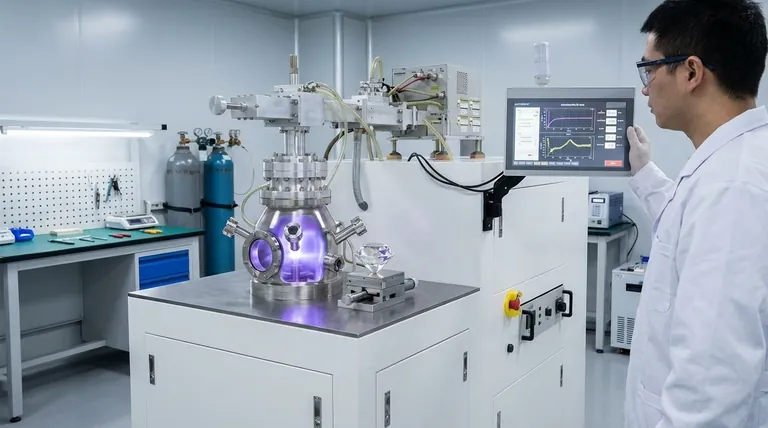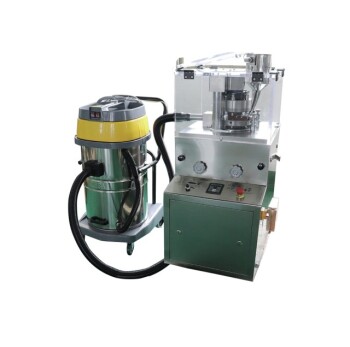At its core, growing a diamond in a lab is a process of applied chemistry and physics, not alchemy. Scientists use two primary methods: High Pressure, High Temperature (HPHT) and Chemical Vapor Deposition (CVD). HPHT replicates the crushing forces of the Earth's mantle, while CVD "builds" a diamond atom-by-atom from a carbon-rich gas. Both create diamonds that are physically, chemically, and optically identical to those found in nature.
Rather than waiting billions of years, scientists can create a genuine diamond in a matter of weeks. They achieve this by starting with a tiny diamond "seed" and then either replicating the Earth's intense pressure cooker environment (HPHT) or by depositing atomic layers of carbon from a superheated gas (CVD).

The Foundation of Diamond Growth: The "Seed"
The Need for a Template
Every lab-grown diamond begins its life as a tiny, paper-thin slice of a pre-existing diamond. This slice is known as the diamond seed or substrate.
This seed acts as the foundational template. Without it, the new carbon atoms would not have the necessary structural guide to arrange themselves into the strong, tetrahedral crystal lattice that defines a diamond.
Ensuring a Perfect Crystal Lattice
The seed's atomic structure dictates how the new carbon atoms bond. As the process unfolds, carbon atoms from the source material are drawn to the seed and lock into place, extending the perfect crystalline structure layer by layer.
Method 1: HPHT (High Pressure, High Temperature)
Replicating the Earth's Mantle
The HPHT method is the original diamond growth technique and directly mimics the natural conditions deep within the Earth where diamonds form.
The process places a diamond seed and a source of pure carbon (like graphite) into a chamber. It also includes a metal catalyst that helps the carbon dissolve and re-form.
The Process in Action
This chamber is subjected to immense pressures, often exceeding 1.5 million pounds per square inch (PSI), and extreme temperatures of around 1500°C (2700°F).
Under these conditions, the metal catalyst melts and dissolves the carbon source. The carbon atoms then migrate through the molten metal toward the slightly cooler diamond seed, where they precipitate and crystallize, growing the diamond.
Method 2: CVD (Chemical Vapor Deposition)
Building a Diamond from Gas
CVD is a newer technique that can be likened to 3D printing on an atomic scale. Instead of immense pressure, it uses a specialized vacuum chamber.
This method allows for greater control over the purity and ultimate size of the resulting diamond.
The Process in Action
A diamond seed is placed inside a sealed vacuum chamber, which is then filled with a carbon-rich gas, such as methane.
This gas is heated to a very high temperature and ionized into a plasma using technology similar to microwaves. This breaks the gas molecules apart, releasing a cloud of pure carbon atoms.
These carbon atoms then "rain down" and deposit onto the cooler diamond seed, building the diamond one atomic layer at a time over several weeks.
Initiating Perfect Growth
To ensure the very first layer of carbon atoms bonds flawlessly to the seed, a specialized technique called bias enhanced nucleation is often used. It applies an electrical field that chemically encourages the carbon atoms to form the correct diamond bonds on the substrate, ensuring the growth process starts perfectly.
Understanding the Trade-offs
Are They Real Diamonds?
Yes. It is critical to understand that diamonds grown via HPHT and CVD are real diamonds. They have the same chemical composition (pure carbon) and crystal structure as mined diamonds.
They are not "simulants" like cubic zirconia or moissanite, which have different chemical and physical properties. They are simply diamonds with a different, and much shorter, origin story.
Different Growth Patterns
The two methods leave behind subtle clues that are only detectable with advanced gemological equipment.
HPHT diamonds grow in a cuboctahedral shape and may contain trace metallic inclusions from the catalyst. CVD diamonds grow in a flat, tabular shape and may have specific strain patterns from the layered growth process. These factors do not impact the gem's beauty or durability.
Method and Application
HPHT is a highly refined process often used to produce smaller diamonds for jewelry or to improve the color of existing diamonds.
CVD is a very scalable process and is generally preferred for creating larger, high-clarity colorless diamonds for gem use, as well as for advanced technical applications in optics and semiconductors.
Making the Right Choice for Your Goal
Understanding the growth method can help you appreciate the technology behind the gem.
- If your primary focus is mimicking the natural process: HPHT is the method that most closely replicates the intense heat and pressure found deep within the Earth.
- If your primary focus is on cutting-edge technology: CVD represents a state-of-the-art approach, building the diamond atom-by-atom in a highly controlled environment.
- If your primary focus is simply authenticity and beauty: Both HPHT and CVD produce genuine diamonds, making either a valid choice based on the specific gem's quality and appearance.
Ultimately, both methods are triumphs of materials science, harnessing the laws of physics to create one of nature's most durable and beautiful materials on demand.
Summary Table:
| Method | Process Description | Key Characteristics |
|---|---|---|
| HPHT | Replicates Earth's mantle with high pressure and temperature. | Grows in a cuboctahedral shape; may have metallic inclusions. |
| CVD | Builds diamond atom-by-atom from a carbon-rich gas in a vacuum. | Grows in a flat, tabular shape; excellent for high-clarity gems. |
Ready to harness the power of advanced materials science in your own lab? KINTEK specializes in providing high-quality lab equipment and consumables, including the precise tools needed for cutting-edge research and development. Whether you're exploring crystal growth or other advanced applications, our expertise can support your success. Contact our team today to discuss how we can meet your laboratory's specific needs.
Visual Guide

Related Products
- Cylindrical Resonator MPCVD Machine System Reactor for Microwave Plasma Chemical Vapor Deposition and Lab Diamond Growth
- HFCVD Machine System Equipment for Drawing Die Nano-Diamond Coating
- 915MHz MPCVD Diamond Machine Microwave Plasma Chemical Vapor Deposition System Reactor
- CVD Diamond Domes for Industrial and Scientific Applications
- Inclined Rotary Plasma Enhanced Chemical Vapor Deposition PECVD Equipment Tube Furnace Machine
People Also Ask
- What is the difference between MPCVD and HFCVD? Choose the Right CVD Method for Your Application
- How to start a lab grown diamond business? Choose the Right Model for Success
- What is a microwave plasma reactor? Unlock Precision Synthesis of High-Performance Materials
- Which lab grown diamond process is best? Focus on Quality, Not the Method
- What are the limitations of diamonds? Beyond the Myth of Perfection



















